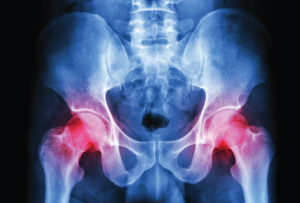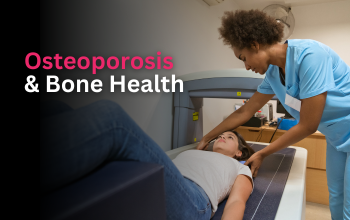The Arthritis Newsletter
Summer 2016Can You Prevent Hip Osteoarthritis?
By: Sheila Kerr
 I was in my 50’s when the changes of osteoarthritis (OA) could be seen on an x-ray of my hip. I joined a growing number of middle aged and younger adults with hip pain and joint damage. My path has been one of continually adapting or removing activities that I love in order to limit pain and extra strain on my joints. Over the past 10 years my hip pain has slowly gone from being intermittent and mild to more frequent and stronger, which leads me to ask:
I was in my 50’s when the changes of osteoarthritis (OA) could be seen on an x-ray of my hip. I joined a growing number of middle aged and younger adults with hip pain and joint damage. My path has been one of continually adapting or removing activities that I love in order to limit pain and extra strain on my joints. Over the past 10 years my hip pain has slowly gone from being intermittent and mild to more frequent and stronger, which leads me to ask:
- Am I looking at a future of increasing pain and disability leading to a joint replacement in my 60’s?
- Will I have another replacement when the first one wears out, perhaps in my 80’s?
- Will I be fit enough for that second replacement to enable me to continue to live independently as I age?
- What will happen to people who get hip pain in their 40’s or earlier?
Searching for the cause of hip OA
In a current study at Arthritis Research Canada, researchers are working to understand the causes of hip OA. The researchers are looking for strategies to slow or prevent progression of the disease. In the first part of the study they discovered that 15-25% of people have a mild boney deformity in the shape of their hip joint bones. This deformity is called Femoral Acetabular Impingement, or FAI. The abnormal shape of the top of the thigh bone or the hip socket bone (or both) can cause pinching or bumping during certain hip movements.
The effect of the deformity can be viewed on the following videos of hip bones during bending:
- Thigh bone CAM deformity: https://youtu.be/qkVxHnCyuxc
- Hip socket PINCER deformity: https://youtu.be/qu5DAJCZjyA
A new technology helps the researchers at Arthritis Research Canada explore the role of FAI in hip pain and OA.
An Upright Open MRI scanner located at the Centre for Hip Health and Mobility in Vancouver, is being used to look at people with and without FAI. The unique thing about this MRI scanner is that images of people’s hips can be taken in positions that are common in activities such as walking, running and cycling instead of just lying down. This Open MRI is the only one in Canada dedicated to research.
Why is this research important?
This research has the potential to identify people at risk for developing OA early, before the hip is damaged. There are medical interventions being studied to treat this condition and potentially limit hip joint damage over time.
Do certain physical activities combined with FAI lead to hip joint damage?
The researchers believe that physical activities involving hip flexion (e.g. household chores, work, some sports and recreational activities) could cause hip pain in people with FAI and eventually lead to OA. The researchers are studying more than 800 people ages 19-49 with and without persistent or recurring bouts of hip pain. They hope to determine how physical motion and FAI combine to damage cartilage, and whether people who have FAI should avoid certain activities in order to maintain a healthy joint.
Understanding causes to develop prevention strategies
This study is important to help create strategies to prevent hip pain, hip OA and the disability they cause for many people worldwide. A team of more than 20 scientists at Arthritis Research Canada are working on this project called IMPAKT-HiP (Investigations in Mobility, Physical Activity, and Knowledge in Hip Pain) which is funded by the Canadian Institutes of Health Research (CIHR).
Dr. Esdaile, leading scientist on the project said: “All too often we don’t look for causes of arthritis. At ARC we hope to find what causes hip OA and determine if we may be able to prevent it. This is our number one goal”.





















































